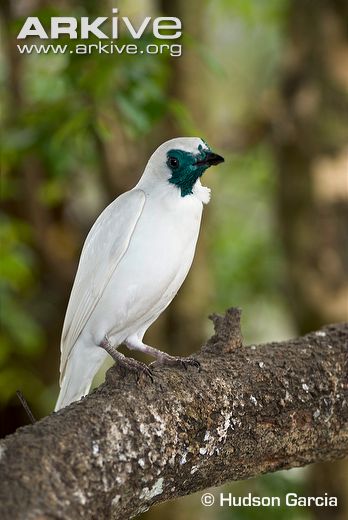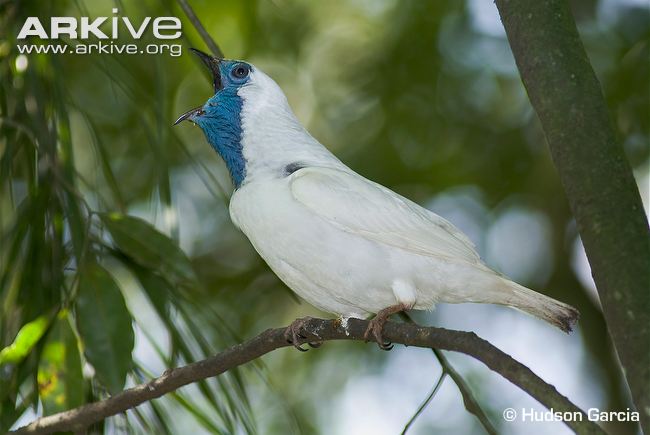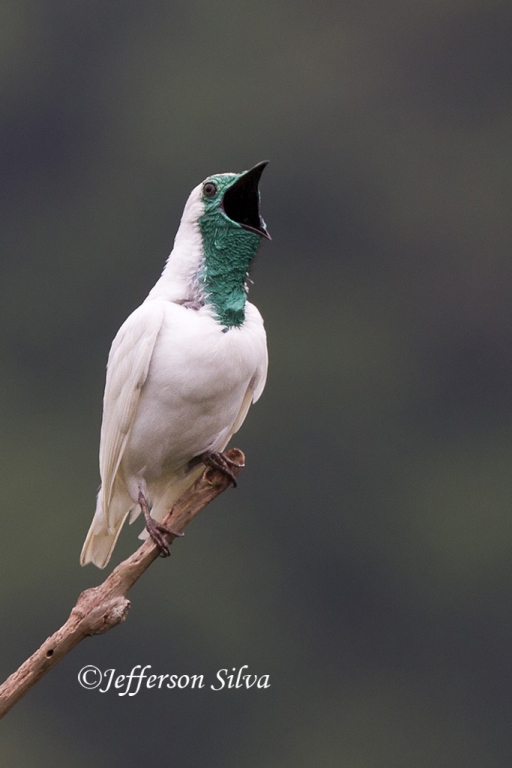
Procnias nudicollis
TAXONOMY
Procnias nudicollis Vieillot, 1817.
OTHER COMMON NAMES
English: Naked-throated bird; French: Araponga а gorge nue;
German: Nacktkehlglцckner; Spanish: Campanero de Garganta
Desnuda.
PHYSICAL CHARACTERISTICS
The bellbirds are distinguished by compact bodies, flat beaks,
short tarsi and a plumage of small feathers. Male bellbirds have
among the loudest calls of any birds. This species accomplishes
this by having a very muscular syrinx, and filling the interclavicular
air sacs. Males also differ from the females in their
plumage coloration. The male is white, and is distinguished by
bare wattles and a bare, inflatable throat skin of greenish color.
Females are predominantly green, and somewhat smaller.
DISTRIBUTION
This species is found in the Atlantic rainforest belt of central
Brazil through eastern Paraguay and northeastern Argentina,
ranging up to 3,370 ft (1,150 m).
HABITAT
Bellbirds live in tropical lowland or montane evergreen rainforest.
They prefer high perches in the canopy, often on bare
tree branches, which project above the crowns of surrounding
trees.
BEHAVIOR
The far-reaching bell-like calls (often described as “bockk”) of
the males characterize their jungle home. Male bellbirds defend
perches jealously against rivals, including other species of
cotingas on occasion. For example, a bare-throated bellbird
displaced a female white-winged cotinga Xipholena atropurpurea
from a tree. While the species appears to be migratory in at
least some regions, this apparently varies among populations.
For example, the species appears to migrate in southeastern
Brazil, be transient in northeastern Argentina, and resident in
Paraguay.
FEEDING ECOLOGY AND DIET
These birds feed on fruit. The short bills with a wide gape are
adaptations for gorging on quantities of fruit, such as (Rapanea
ferruginea). This species has also been observed eating in a Cecropia
tree.
REPRODUCTIVE BIOLOGY
This species builds a shallow nest that is approximately 6.3 in
(16 cm) across. The nest is made of very little construction
material, and is built on open branches. One or two eggs are
laid per clutch; the eggs are oval and reddish brown, with dark
spots at the rounder end. Female cellbirds care for the young
alone, regurgitating fruit and cleaning the nest of fecal sacks
and regurgitated seeds.
CONSERVATION STATUS
Near Threatened due to habitat fragmentation, development
such as road building, and exploitation for the cage bird
trade (especially in Brazil) being the main factors. The fragmentation
is primarily due to agrarian conversion and deforestation
for mining concessions. In all likelihood this species
is declining
SIGNIFICANCE TO HUMANS
None known.
Other popular Animals
Photo Gallery of - Bare-throated bellbird




 Animalia Life
Animalia Life